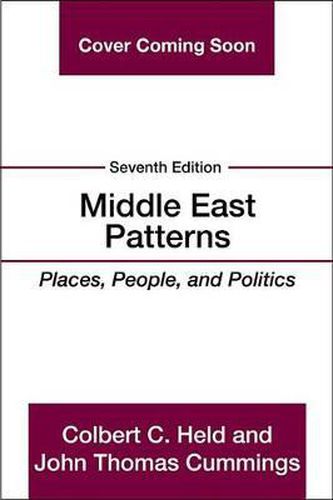Readings Newsletter
Become a Readings Member to make your shopping experience even easier.
Sign in or sign up for free!
You’re not far away from qualifying for FREE standard shipping within Australia
You’ve qualified for FREE standard shipping within Australia
The cart is loading…






Now in its seventh edition, Middle East Patterns continues to be the most comprehensive and authoritative geographical study of the region. Coauthors Colbert C. Held and John Thomas Cummings examine a wide range of geographic, ethnographic, and political patterns of the Middle East, and explore their relationship with, and effect on, the history, economics and human and social development of the region. The book is divided into two parts: The first covers the region from a topical perspective, and the second provides in-depth country-by-country coverage.The seventh edition now includes new chapters on rural life and urban life in Part I, a new chapter on North Africa in Part II, and additional discussions of environmental issues and gender. It has also been updated with the latest data and coverage of events since 2013, including the aftermath of the Arab uprisings, the Libyan and Syrian crises, and the rise of ISIS. Richly illustrated with more than 200 photos and maps and supported by pedagogical elements like key point summaries and a glossary, this acclaimed book remains the best and most accessible resource for students and general readers who seek to understand the spatial dynamics of the Middle East.
$9.00 standard shipping within Australia
FREE standard shipping within Australia for orders over $100.00
Express & International shipping calculated at checkout
Now in its seventh edition, Middle East Patterns continues to be the most comprehensive and authoritative geographical study of the region. Coauthors Colbert C. Held and John Thomas Cummings examine a wide range of geographic, ethnographic, and political patterns of the Middle East, and explore their relationship with, and effect on, the history, economics and human and social development of the region. The book is divided into two parts: The first covers the region from a topical perspective, and the second provides in-depth country-by-country coverage.The seventh edition now includes new chapters on rural life and urban life in Part I, a new chapter on North Africa in Part II, and additional discussions of environmental issues and gender. It has also been updated with the latest data and coverage of events since 2013, including the aftermath of the Arab uprisings, the Libyan and Syrian crises, and the rise of ISIS. Richly illustrated with more than 200 photos and maps and supported by pedagogical elements like key point summaries and a glossary, this acclaimed book remains the best and most accessible resource for students and general readers who seek to understand the spatial dynamics of the Middle East.